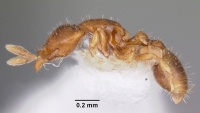Strumigenys daspleta
| Strumigenys daspleta | |
|---|---|

| |
| Scientific classification | |
| Kingdom: | Animalia |
| Phylum: | Arthropoda |
| Class: | Insecta |
| Order: | Hymenoptera |
| Family: | Formicidae |
| Subfamily: | Myrmicinae |
| Tribe: | Attini |
| Genus: | Strumigenys |
| Species: | S. daspleta |
| Binomial name | |
| Strumigenys daspleta (Bolton, 2000) | |
Nothing is known about the biology of Strumigenys daspleta.
Identification
Bolton (2000) – A member of the Strumigenys mnemosyne-group. For discussion of this species see under Strumigenys mnemosyne.
Keys including this Species
Distribution
Distribution based on Regional Taxon Lists
Indo-Australian Region: Borneo (type locality), Indonesia, Malaysia.
Distribution based on AntMaps
Distribution based on AntWeb specimens
Check data from AntWeb
Countries Occupied
| Number of countries occupied by this species based on AntWiki Regional Taxon Lists. In general, fewer countries occupied indicates a narrower range, while more countries indicates a more widespread species. |

|
Estimated Abundance
| Relative abundance based on number of AntMaps records per species (this species within the purple bar). Fewer records (to the left) indicates a less abundant/encountered species while more records (to the right) indicates more abundant/encountered species. |

|
Biology
|
Castes
Nomenclature
The following information is derived from Barry Bolton's Online Catalogue of the Ants of the World.
- daspleta. Pyramica daspleta Bolton, 2000: 445 (w.) BORNEO. Combination in Strumigenys: Baroni Urbani & De Andrade, 2007: 118
Unless otherwise noted the text for the remainder of this section is reported from the publication that includes the original description.
Description
Worker
Holotype. TL 1.6, HL 0.42, HW 0.34, CI 81, ML 0.07, MI 17, SL 0.18, SI 53, PW 0.20, AL 0.41. With the characters of the group and answering the general description of mnemosyne, but differing as follows.
1 Leading edge of scape with 2-3 elongate straight hairs that project anterodorsally.
2 With head in full-face view the dorsolateral margin from the frontal lobe to the occipital corner with 6 or more freely projecting hairs.
3 Posterior margins of occipital lobes with a fenestra-like or blister-like area of translucent cuticle that extends more than half the length of the margin on each side.
4 Standing hairs on cephalic dorsum short and stubbly, abundant, too numerous to count easily.
5 Standing hairs on dorsal alitrunk short and stubbly, abundant, not arranged in distinct pairs.
6 Node of petiole in profile with the dorsal outline broadly rounded.
Type Material
Holotype worker, Malaysia: Sarawak, Gn. Penrissen, 1000 m., 23.v.1994, no. 9a (Burckhardt & Lobl) (Musee d'Histoire Naturelle Genève).
References
- Baroni Urbani, C. & De Andrade, M.L. 2007. The ant tribe Dacetini: limits and constituent genera, with descriptions of new species. Annali del Museo Civico di Storia Naturale “G. Doria” 99:1-191.
- Bolton, B. 2000. The ant tribe Dacetini. Memoirs of the American Entomological Institute. 65:1-1028. (page 445, worker described)
References based on Global Ant Biodiversity Informatics
- Pfeiffer M.; Mezger, D.; Hosoishi, S.; Bakhtiar, E. Y.; Kohout, R. J. 2011. The Formicidae of Borneo (Insecta: Hymenoptera): a preliminary species list. Asian Myrmecology 4:9-58

